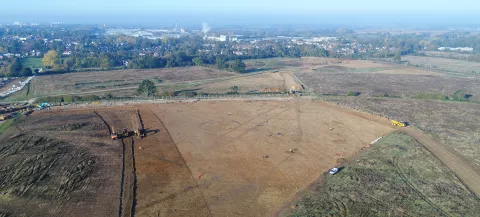
Oxford Archaeology (OA) and the Cambridge Archaeological Unit (CAU) have recently collaborated on a programme of pottery refitting for a large assemblage of Early Neolithic ceramics from Gilden Way, Harlow. The pottery, which totals over 8,000 sherds, was recovered from a causewayed enclosure, excavated by Oxford Archaeology in 2017 in advance of a residential development on behalf of Taylor Wimpey, Persimmon Homes and Barratt Homes.
The benefit of doing a project like this is not only in the added value you get from being able to study material culture much more closely than normal – literally in the way the pottery looks and feels from one vessel to another – but also in the collaborative experience of sharing ideas and knowledge with colleagues from other organisations.
Tom Phillips, Senior Project Manager, OA
Causewayed enclosures represent some of the earliest examples of enclosed spaces in Britain, first appearing around 3700 BC in the Thames estuary and eastern England, before spreading across the rest of southern England and south Wales during the next few generations. They are often oval in plan and are formed of short, discontinuous lengths of bank and ditch separated by causeways. Rather than being settlements or places of permanent occupation, they are thought to be places that groups of Neolithic people used communally, possibly for feasting or for ceremonies to remember their ancestors. Approximately 80 causewayed enclosures are now known in the British Isles, which means they remain a rare type of monument and it is highly significant when a previously unknown enclosure can be investigated through full excavation, particularly in a part of the country where they appeared early on. Overlooking a tributary of the River Stort, the Harlow enclosure was semi-circular in shape and formed of a single circuit, its ditch segments and smaller internal pits rich in the remains of broken pottery vessels, flint tools and charred food remains.
When an opportunity arises to get your eyes and hands on a very large assemblage of Early Neolithic pottery from a ‘single context’ you take it. There is no substitute for direct, practical engagement. You only learn. Vessel range, variability of form, surface treatment, fabric, and decoration – all these details are absorbed and stored ready for the next time someone dangles a muddy sherd in front of you and enquires ‘is this Neolithic pottery?!’
Mark Knight, Senior Project Officer, CAU
In a space provided by the School of the Humanities and Social Sciences, University of Cambridge, the refitting project involved a team of prehistoric pottery specialists (and helpers) from OA and CAU laying out thousands of sherds of pottery like a very complex jigsaw puzzle, before closely handling and inspecting the assemblage over the course of a week.
At one level, the purpose of the refitting was to see how much of an individual pot could be pieced back together, establishing a straightforward catalogue of vessels (and with this to begin to build a sense of the scale of occupation). At the same time, we wanted to understand something about the processes of breakage and deposition. Were the vessels deposited whole as discrete acts? Or were they part of a more general accumulation of occupation related material generated over time? Simultaneously, the refitting project helped to establish definite connections between different parts of the monument, demonstrating clear relationships between ditch segments tens of metres apart. Overall, the refitting project will help determine the timespan of the causewayed enclosure and resolve whether the monument represented a short-term episode or a long-term event.
As a junior specialist, the days were invaluable to me. Working on an assemblage of that size and time period was a luxury that I was happy to be a part of. The experience of not only working with another company but other specialists was a joy and a learning opportunity that can't be replaced. Everyone in the room was just there for the pottery to learn and connect with the material.
Petra Jones, Junior Prehistoric Pottery Specialist, CAU
